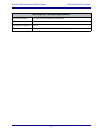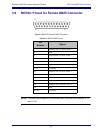
Euphonix MADI Converters Operation Manual DM714 and MD704 Converters
28
3.6 Synchronization
3.6.1 DM714
The DM714’s Sample Rate is set externally by one of two source signals or internally
by crystals and associated circuitry. The Sample Rate Source is determined automati-
cally by the presence of signals when the DM714 is powered on. The order in which
external signals are tested for presence is: AES, Word, Internal.
The detected signal immediately becomes the source for the DM714’s sample rate
clock. The auto-sensed Sample Rate Source can be overridden using the button on the
front panel of the DM714, below the Sample Rate Source LEDs. If neither AES nor
Word Clock signals are present, the DM714 uses its internal clock derived from on-
board voltage-controlled crystal.
The default internal Sample Rate of the DM714 is 48 kHz. This default internal rate can
be overridden with the Sample Rate button on the front panel of the DM714 (directly
below the Sample Rate LEDs) to 44.1, 48 or 96 kHz.
3.6.2 MD704
The MD704 detects Sample Rate and Sample Rate Source like the DM714 with the
following two differences:
• Since the MD704 is always a slave to an external Sample Rate Source, there is
no internal Sample Rate setting.
• The MD704 can use MADI in addition to AES or Word Clock as a Sample Rate
Source, and detects the presence of these signals in the following order: AES,
Word, MADI.
When a signal is detected, it immediately becomes the sample rate clock of the MD704.
The auto-sensed Sample Rate Source can be overridden with the Sample Rate Source
button on the front panel of the MD704, below the Sample Rate Source LEDs.
NOTE: The converters occasionally do not lock to a 96 kHz AES Sync signal. This
condition can normally be remedied by cycling the converter’s power, discon-
necting and reconnecting the AES Sync signal, or using Word Clock.


















